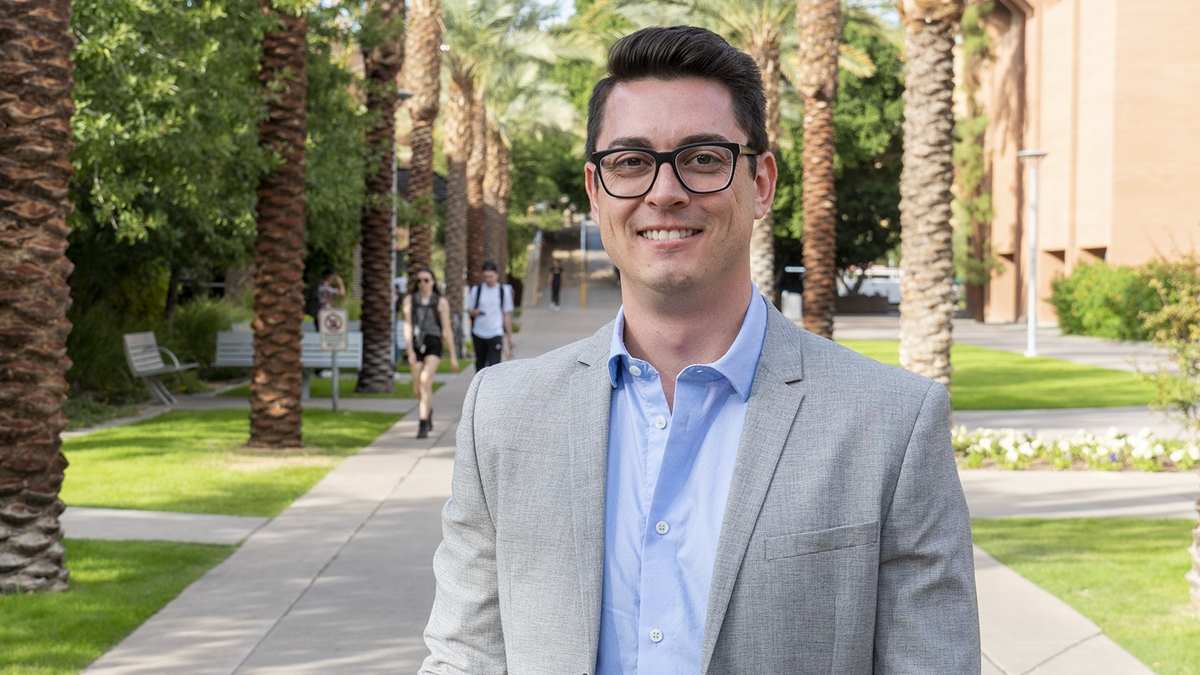ASU's School of Molecular Sciences grad awarded prestigious NRC postdoc

Jacob Garcia from ASU's School of Molecular Sciences has just graduated with a PhD in chemistry. Photo by Mary Zhu/ASU
As an undergraduate, Jacob Garcia was uncertain what his future would hold. His older brothers, one very tech savvy and the other a doctor, sparked his interest in science and chemistry in particular.
After visiting Arizona State University for the Western Alliance to Expand Student Opportunities’ Conferences, Garcia — who hails from Evergreen, Colorado — was extremely impressed and decided to come here for his doctoral studies.
He heard a talk from Assistant Professor Scott Sayres from ASU’s School of Molecular Sciences (SMS) and was sold on working in his ultrafast laser lab.
“Working with Professor Scott Sayres in the Ultrafast Laser Lab of SMS has been an absolute pleasure over the last 5-plus years,” enthused Garcia. “Scott is one of the most passionate, helpful and motivated advisers a student could ask for.
“He has provided a welcoming and supportive environment for me to grow as a scientist and as an external member of the ASU community. It is an honor to have been one of Professor Scott Sayres' first graduate students, and to be the first PhD student to graduate from his lab. I have greatly enjoyed helping to get his lab started, to install instrumentation and to assist in his undoubtedly impressive future as a scientist.”
Sayres, who is also a faculty member in the Biodesign Institute’s Center for Applied Structural Discovery, reciprocated Garcia’s sentiments.
“It has been a pleasure working closely with Jake Garcia over the past few years,” Sayres said. “He has become a talented experimentalist, and as a member of my research group he has started an entirely new research direction. He has made several discoveries that advance our knowledge about how energy flows through the smallest possible building blocks (clusters) of materials.
“Specifically, Jake’s work may help to identify the ultimate size regime for peak photocatalytic efficiency of metal oxides and will lead to the development of advanced materials. His many accomplishments foretell of an exciting career ahead, and I look forward to following it closely. “
After being offered a job in industry, Garcia found out recently that he was awarded a highly competitive National Institute of Standards and Technology-affiliated National Research Council (NRC) associateship.
The mission of the NRC Research Associateship Programs is to promote excellence in scientific and technological research conducted by the U.S. government through postdoctoral research opportunities at sponsoring federal laboratories and affiliated institutions. Garcia will be on the University of Colorado Boulder campus and will be working on atomic probe tomography.
Garcia stated that both the School of Molecular Sciences and ASU have been an extremely welcoming community providing the perfect environment for collaborations.
Garcia recently successfully defended his doctoral thesis, titled “The ultrafast excited — state dynamics of first-row transition metal oxide clusters.” His laser studies on uncharged transition metal oxide clusters could ultimately lead to the development of new and less expensive industrial catalysts. It might also contribute to a better understanding of the universe since iron oxides are observed in the emission spectra of stars.
Garcia is extremely excited about his first-row (of the periodic table) transition metal oxide cluster studies as these metals are not only cheap but environmentally benign.
While at ASU, he helped organize two AZ AstroBio conferences. He also was very active with ASU’s Graduate and Professional Student Association, where he advocated on behalf of students working on a number of issues they were facing around campus.
He also helped start ASU’s Chemical and Biological Sciences Society, which has expanded the interdisciplinary work that goes on between the School of Molecular Sciences, the School of Earth and Space Exploration, the School of Life Sciences and others. He was treasurer of the Graduate Student Council in the School of Molecular Sciences and participated in intramural sports and other activities, pointing out that the Arizona Outdoors Club (based at ASU) is a wonderful organization that hosts camping and hiking activities to explore the state.
Garcia’s advice to graduate students is try to get out of the lab every so often, make some new friends and to try to join the broader ASU community. There are lots of opportunities to be part of something bigger — something Garcia loved about ASU. He also suggested that if students have a research idea that they’re excited about, they should give it a try and ask for forgiveness later. You never know, he said — something really exciting might come out of it.
He has already published four papers (as first author) in prestigious journals with five more submitted or along the way in the next several months. His aforementioned recently offered postdoc opens up the possibility of an academic career. Garcia will be working with a team of highly qualified and exciting scientists on atomic probe tomography.
More Science and technology

ASU professor breeds new tomato variety, the 'Desert Dew'
In an era defined by climate volatility and resource scarcity, researchers are developing crops that can survive — and thrive —…

Science meets play: ASU researcher makes developmental science hands-on for families
On a Friday morning at the Edna Vihel Arts Center in Tempe, toddlers dip paint brushes into bright colors, decorating paper…

ASU water polo player defends the goal — and our data
Marie Rudasics is the last line of defense.Six players advance across the pool with a single objective in mind: making sure that…

